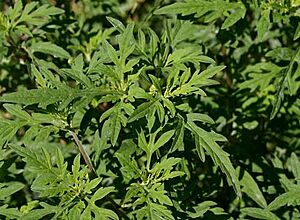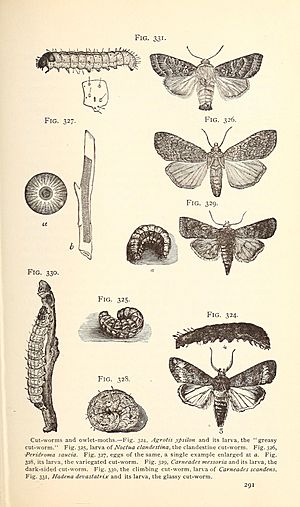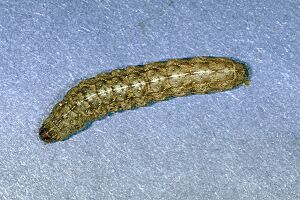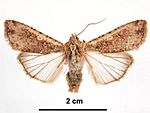Pearly underwing facts for kids
Quick facts for kids Pearly underwing |
|
|---|---|
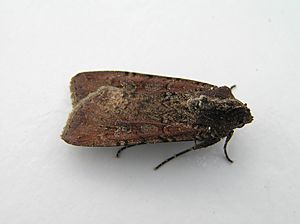 |
|
| Scientific classification | |
| Kingdom: | |
| Phylum: | |
| Class: | |
| Order: | |
| Family: | |
| Genus: |
Peridroma
|
| Species: |
P. saucia
|
| Binomial name | |
| Peridroma saucia (Hübner, 1808)
|
|
| Synonyms | |
|
|
The pearly underwing or variegated cutworm (scientific name: Peridroma saucia) is a type of moth. It belongs to the Noctuidae family, which includes many kinds of owlet moths. Jacob Hübner first described this species in 1808.
You can find this moth in many parts of the world, including North and South America, Europe, Asia, and Africa. The variegated cutworm is known for eating many different plants, especially common fruits and vegetables. Because of this, it is considered one of the most damaging garden pests. Its larvae (young moths) can cause a lot of harm to crops.
The moth usually has two to four generations (life cycles) each year. Its development slows down in colder weather. This shows that it is a migratory moth, meaning it travels. It moves to northern areas when it's warm and returns to southern areas when it gets cold.
Contents
Where the Moth Lives
The variegated cutworm moth lives in many places around the world. These include North and South America, the Hawaiian Islands, Europe, Asia, and North Africa. We are not sure where the moth first came from. The earliest records of it are from Europe in 1790.
The moth was first seen in North America in 1841. Today, it mostly lives in Southern Canada and the Northern United States. In the 1970s, P. saucia was found in Japan. There, it is called "nise-tamanayaga", which means "false black cutworm moth". Scientists are still studying how widely it has spread in Japan.
What the Moth Eats
The young variegated cutworm, called a larva, eats many different plants. It is known as a common garden pest because of this.
Common Plants
The larvae eat many vegetables and fruits.
Vegetables
- Beta vulgaris – beets
- Brassica oleracea – cabbage
- Lactuca sativa – lettuce
- Solanum tuberosum – potato
- Medicago sativa – alfalfa
- Plantago sp. – plantain
- Zea mays – corn/maize
- Beta vulgaris – sugarbeet
Fruits
- Solanum lycopersicum – tomato
- Malus pumila – apple
- Prunus armeniaca – apricot
- Persea americana – avocado
- Prunus sp. – cherry
- Vitis vinifera – currant
- Ribes uvacrispa – gooseberry
- Vitis labrusca – grape
- Citrus limon – lemon
- Morus – mulberry
- Citrus sinensis – orange
- Prunus – plum
- Rubus idaeus – raspberry
- Fragaria ananassa – strawberry
Other Plants
- Hordeum vulgare – barley
- Trifolium sp. – clover
- Gossypium spp. – cotton
- Linum usitatissimum – flax
- Humulus lupulus – hops
- Mentha spp. – mint
- Helianthus annuus – sunflower
- Melilotus – sweet clover
- Nicotiana spp. – tobacco
- Triticum aestivum – wheat
Weeds
P. saucia also eats weeds, though less often than fruits and vegetables. Some weeds it feeds on are:
- Datura sp. – jimsonweed
- Rumex sp. – dock
- Eupatorium capillifolium – dogfennel
- Ambrosia sp. – ragweed
- Capsella bursa-pastoris – shepherd's purse
Feeding Habits
The variegated cutworm mainly feeds after the sun sets. During the day, the larvae often hide in the soil or under other things. They move to plants in the evenings to eat. These larvae are known to eat a lot of plants as they grow. Studies show they can eat a large amount of sugarbeet or potato leaves during their larval stage.
Reproduction
Laying Eggs
Female variegated cutworm moths start laying eggs one to two weeks after they become adults. One reason this moth is such a common pest is that it lays many eggs. It is also hard to control how many eggs they lay.
Studies show that female moths live longer in slightly colder temperatures (15°C). However, they lay more eggs in slightly warmer temperatures (18–24°C). This means they are more successful at having babies in warmer weather. A female moth can lay between 1200 and 1400 eggs in her lifetime.
Life Cycle
The variegated cutworm goes through two to four generations in one year. In colder places, like Canada, the moth usually has two generations. In warmer areas, it has three to four generations each year.
Even though some pupae and larvae can survive winter, adult moths still fly into cooler areas each spring. They return to warmer areas each fall. These moths travel long distances when they migrate. This makes it hard for scientists to count how many generations there are just by looking at adult moths.
Egg Stage
The egg is shaped like half a sphere and is flat on the bottom. It is usually attached to a leaf or plant stem. The egg surface has ridges that go from the center to the edges. Each egg is about 0.55–0.58 millimeters wide and 0.40–0.45 millimeters tall.
The egg starts white and turns brown as it gets older. Eggs are usually laid in large groups. In warm weather (20–30°C), the egg stage lasts about four to six days. In cold weather (15°C), it can last up to ten days.
Larva Stage
The variegated cutworm larva goes through six stages, called instars. The larvae are usually brownish-gray to grayish-black. They have a clear yellow or white spot on the back of their first four to six body segments.
Also, older larvae have a black W-shaped mark on their eighth body segment. They also have a black line along their sides, above their spiracles (breathing holes). The head of the larva is usually orange-brown with darker spots.
Pupa Stage
The pupal stage of P. saucia lasts about 33 days in colder temperatures (15°C). It lasts about 13 days in warmer temperatures (25°C). The pupa is 15–23 millimeters long and 5–6 millimeters wide. It is a mahogany brown color. Larvae dig a small hole in the soil and turn into pupae near the soil surface.
Adult Moth
The adult moth is quite large. Its wingspan is about 43–50 millimeters. The front wings are grayish-brown with a reddish color underneath. They have darker brown areas in the middle and along the edges. The wings have seven short, black marks, which is a special feature of this moth.
The moth's hindwings are either shiny or white. They have brown veins and brown shading on the edges. The head and upper body (thorax) of the moth are dark brown. Its lower body (abdomen) is a lighter brown.
Migration
Regional Travel
The variegated cutworm can survive winter as both larvae and adults. However, studies show the moth cannot live for more than eight weeks at 0°C. It cannot live for more than four weeks at -2°C. This means the moth does not spend winter in the very cold northern parts of Canada where it lives in summer.
The moth flies in several generations from May to November, depending on the location. In warmer months, the moth moves from the southwest to the northeast. The common outbreaks seen in spring are thought to be from adult moths migrating north. These moths come from areas in the Southern United States where they spent the winter.
Local Travel
P. saucia larvae have also been seen moving in large groups, like army-worms. This means they travel from one field to another in big numbers. As they move, the larvae destroy plants and crops in their path.
Enemies
Predators and Parasites
The variegated cutworm has several enemies. Wasps and flies that are parasitoids cause most of the deaths of larvae each year. Parasitoids are insects that lay their eggs inside or on another insect. When the eggs hatch, the young parasitoids eat the host insect.
Many types of wasps and flies attack P. saucia larvae. Some common ones include Apanteles xylinus, Chelonus insularis, Meteorus leviventris, Campoletis sonorensis, Bonnetia comta, and Voria ruralis. It is likely that many other species of wasps and flies also attack this moth.
How Moths Find Mates
Pheromones
Female moths produce a special scent, called a pheromone, to attract male moths. These pheromone glands are in the last body segments of the female variegated cutworm. The main part of this scent is (Z)-11-hexadecenyl acetate. A smaller part is (Z)-9-tetradecenyl acetate.
Interactions with Humans
A Pest of Crop Plants
Many people describe the variegated cutworm as one of the most harmful pests to vegetables. The moth causes damage by cutting off plants right at the soil surface, which quickly destroys the crop. The larvae also eat leaves and fruit from plants and trees. They can even eat buds and stems.
These larvae are common in low-growing plants. However, what makes them especially dangerous is their ability to climb trees to eat leaves. Most of the damage to crops happens in the warm months. Damage can happen very quickly, with entire gardens and fields being destroyed in just a few days. Around early August, when the temperature starts to drop, the damage lessens. The P. saucia moths begin to disappear from gardens and fields.
Pest Control Methods
There are many ways to control the damage caused by P. saucia in gardens and on crops.
- Insecticides are often used to reduce damage from larvae.
- Another common method is to keep gardens clean. Removing weeds and trash from gardens helps reduce the number of variegated cutworm larvae.
- Digging a ditch or trench with straight sides can help stop the larvae. The larvae are known to move in large groups. Digging a trench about 12 inches deep in their path can be effective.
- Painting tar or pitch around a tree can work for a short time, but you need to put on a fresh coat every few days.
- Tying a narrow band of cotton around a tree with string also works until it gets wet.
- Smaller plants are more likely to be damaged. It is a good idea to wrap the stem of these plants with smooth paper to stop larvae from climbing them.
- Lastly, putting poultry like turkeys and guinea hens in gardens helps control the pest. These birds tend to look for and eat P. saucia larvae and pupae.


